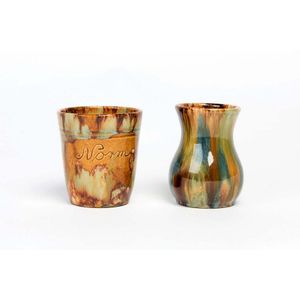Reef and Glasform Vases by Pantano and Ditchfield
You must be a subscriber, and be logged in to view price and dealer details.
Subscribe Now to view actual auction price for this item
When you subscribe, you have the option of setting the currency in which to display prices to $Au, $US, $NZ or Stg.
- Decor Bois - "Decor bois" is a French term that translates to "wood decor" in English. It refers to decorative elements painted on porcelain items that simulate decorations in timber, such as carvings.
- Emeralds - Emeralds have been used in jewellery making for thousands of years, and are prized for their deep green colour, which is caused by the presence of chromium and vanadium in the mineral beryl. Because of their rare colour, emeralds are often more valuable than diamonds of a similar size and quality. In jewellery making, emeralds are typically cut into round or oval shapes to maximize their color and clarity. They are often set in gold or platinum and used as the centrepiece of a piece of jewellery, such as a ring or necklace. They can also be used in combination with other gems, such as diamonds, to create intricate and beautiful designs.
- Irridescent Glass - Iridescent glass has a shimmering or rainbow-like appearance due to the way it reflects light. It is created by applying a thin layer of metal oxides to the surface of the glass while it is still hot and malleable, which then creates an interference effect that produces a range of colours as the light reflects off the surface. The exact colours and patterns created by iridescent glass depend on the specific types of metal oxides used and the techniques used to apply them.
Iridescent glass was first developed in the late 19th century, and quickly became popular for use in decorative art glass and stained glass windows. Some of the most famous examples of iridescent glass were created by artists such as Louis Comfort Tiffany and his studio, who used it extensively in their distinctive lamps, vases, and other decorative objects. - Aventurine Glass - Aventurine glass is a type of glass where small flakes of gold, copper, or silver color form in the glass and provide a glitter or sparkle to the glass when seen in the light. The small flakes are created by adding copper, gold or silver to the molten glass during the glassmaking process.
This item has been included into following indexes:
Visually similar items

Famile rose-verte vase Kangxi mark to base decorated with dignitaries attended by soldiers possibly entertained by three characters to a seated official and also surrounded by Chinese flora. the shoulder decorated with four cartouches on a symmetrical grou

John Campbell Pottery, An orange, brown and blue glaze beaker and vase, the beaker inscribed 'Norm', both inscribed 'John Campbell, Tasmania, 9 cm and 10 cm high

Two Loetz 'Papillon' glass vases in cobalt and Rubin (ruby), Introduced 1898, iridescent vases both with the distinctive pebble style decor, including a conical cobalt vase with three compressions to the body with peacock blue and aqua colours, and a strai

A Chinese green crackle glaze vase, late-19th century, Qing Dynasty. Height 25.5 cm
